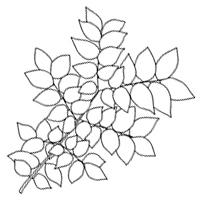Kentucky coffee-tree
Chicot févier
Gymnocladus dioicus (L.) K.KochCaesalpinaceae (cassia family)Origin: Eastern North America

Origin: Eastern North America

Kentucky coffee-tree is a medium-sized tree with a narrow crown.
Read more about Tree, Bark, TwigsLeaves are very large, divided into about 70 oval leaflets in a twice pinnate arrangement.
Read more about LeavesFlowers are fragrant, greenish-white, with 5 petals, and are borne in large clusters.
Read more about FlowersKentucky coffee-tree is a medium-sized tree with a narrow crown. It grows to 25 m (82') in height and 60 cm (about 2') in diameter.
In winter, the branches and stout twigs may appear dead because the tiny buds make the branches look very bare.
Buds are small, 6 - 9 mm (about 1/4") long with several scales that are covered with dark, silky hairs. The leaf scar is shield-shaped, with several raised vascular bundles.
Leaves are very large, 30 - 90 cm (1' - 3') long, and are twice pinnately compound, with about 70 leaflets. Each leaf has four to six paired "branches" of leaflets. Each "branch" holds 8 - 16 leaflets.
Individual leaflets are oval with a short, tapered tip and smooth edges. Leaflets are 4 - 6 cm long (1 1/2" - 2 1/4") long.
Flowers are borne in clusters, with male and female flowers on separate trees. Male flowers are in branched clusters up to 10 cm (4") long.
Flowers are hairy, greenish-white, about 2 - 3 cm (3/4" - 1") across, with 5 petals. Male and female flowers are similar in appearance.
Inside each pod, several flattened, brown seeds about 2 cm (3/4") long, are embedded in a sticky pulp.
Distribution
Kentucky coffee-tree is a component of the eastern deciduous forest. It is uncommon in the wild, especially in Canada, where it occurs only in the southern-most portion of the Carolinian Region of southern Ontario. It is thought that the seeds of Kentucky coffee-tree were dispersed by mastodons and this is why, in the absence of a replacement seed dispersal animal, they are so rare in the wild today (see American Museum of Natural History). However, it has been successfully cultivated and planted in urban areas well beyond its natural range. Kentucky coffee-tree is one of only two species in the genus Gymnocladus. The other is native to China.
Kentucky coffee-tree has the largest leaves of any native tree in Canada, although the individual leaflets may be mistaken for separate leaves. Each branch consists of about 70 leaflets divided amongst lateral stalks that branch off a larger central stalk (the rachis).
Kentucky coffee-tree leaflets rotate on their stalks throughout the day in response to the angle of the sun. They position themselves so that the edges, rather than the flat sides, directly face the sun. It is thought that this is a strategy to conserve moisture.
Derivation of names
The name Gymnocladus means "naked branch" from the Greek gymnos, meaning naked, and klados, meaning branch, a reference to the branches which appear dead in the winter. The species name dioicus means "two dwellings" in reference to the separate male and female trees. Dioicus comes from the Greek di meaning two and oikos meaning dwelling.
Human use and wildlife value
Settlers to North America reportedly roasted the seeds and ground them as a substitute for coffee which led to the tree's common name. The raw seeds are poisonous but roasting them is thought to destroy the toxic compounds. This has not been definitively proven so it is best to avoid eating them altogether as wildlife do.
Commercial use
Because of Kentucky coffee-tree's rarity its wood has little commercial value. In the past it has been used in the manufacture of cabinets and fence posts.
Kentucky coffee-tree's place in Toronto's urban forest
Kentucky coffee-tree has been more widely planted in recent years as part of overall efforts to increase the diversity of tree species in the urban forest. It can now be found throughout the city on private property and in city parks where older plantings sometimes form colonies.
Landscape value and potential for home planting
Kentucky coffee-tree has proven to be a hardy urban tree. It is resistant to the harmful effects of road salt and is not prone to disease. It is adaptable to a range of conditions, but grows best in sunny open sites with deep, rich, moist soils. It is one of the last trees to leaf-out in the spring - often not until early June.
This tree is available for planting through the City of Toronto's street tree program and LEAF's backyard tree program .
Links to maps at Canadian Tree Tours: